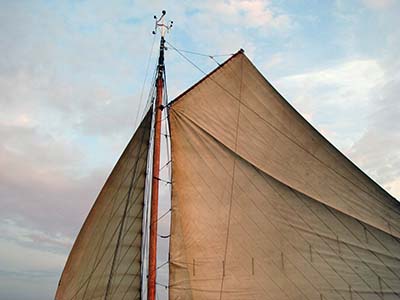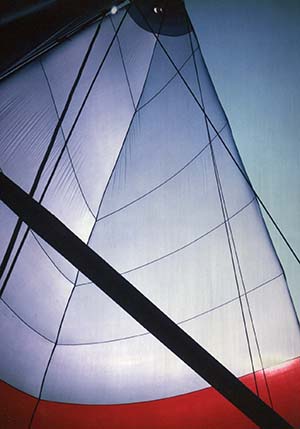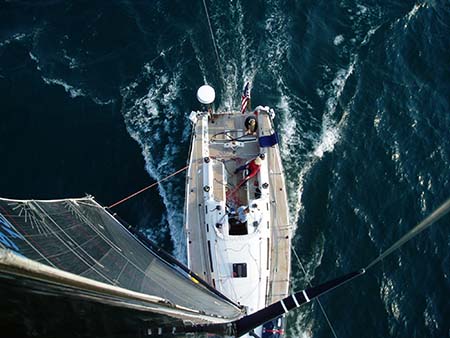SAILS AND USE
Reducing Power By Reefing
 As the wind increases in your sails you need to progressively flatten them to reduce power. This can be achieved by ensuring that halyards are tight (with no sail wrinkles along the luff) and that the clew of the main is at maximum out position.
As the wind increases in your sails you need to progressively flatten them to reduce power. This can be achieved by ensuring that halyards are tight (with no sail wrinkles along the luff) and that the clew of the main is at maximum out position.
If you then still have too much pressure the sail area has to be reduced, either by changing sails or reefing. Modern systems are now so efficient that with a little practice on the system, it is straightforward to reef sails, even shorthanded in strong wind.
You will probably need to re-adjust the leech line. Tension it just enough to stop the leech flapping and remember to release it when you shake out the reef.
Mainsail Reefing
Before you leave the dock, the reefing lines should be rigged. It is very difficult to do this later, often when you may need to, on a rolling or sloping deck with the boom end over the water. Your boom is fitted with all the equipment for reefing. Reef lines should be loaded so that they pull the new clew down to the boom track and aft, to flatten the sail. When reefing ease the boom vang. Ease the halyard and the luff on the sail will fall. Hook on the required tack cringle to the boom reef hooks and re-tension the luff.
Now tighten the reef line by turning it around a winch. Use the locking lever at the forward end of the boom to secure the reefing line. Sheet the mainsail and re-adjust the boom vang. Shaking out reefs is just as easy. Just reverse the process, but watch out for the outer end of the boom falling and swinging into the cockipt. For single line reefing, see separate details.
Boom - Single Line Reefing
 A lazyjack system can be fitted to collect the sail when it is reefed or lowered. This is particulary useful for fully battened sails. You may need to check that the lines do not foul the batten ends when hoisting.
A lazyjack system can be fitted to collect the sail when it is reefed or lowered. This is particulary useful for fully battened sails. You may need to check that the lines do not foul the batten ends when hoisting.
Lazyjacks & Battened Sails
The in-line fractional spreader configuration should be set up as for the masthead rig, the only difference being the addition of running backstay to tension the forestay. More mast bend can be expected and the sailmaker will cut the mainsail accordingly. The mast should always be set up with some fore/aft bend as these masts can invert, particulary in stronger winds.
Using The Boom Vang
The boom vang is a powerful sail control and should always be used with care. It tensions the leech of the sail and will improve sail shape on the wind and when running. In stronger winds the correct vang tension will stop the leech from twisting and creating a rolling motion downwind with light winds, it is easing the mainsail leech and replace boom topping list. It is always a good practice when bearing away in windy conditions to ease the boom vang, in order to avoid overloading which can cause loss of control or damage to the boom.
Using The Spinnaker Pole
Good crew preparation will make spinnaker setting easy. Plan who will do what jobs, including spinnaker halyard, guy an sheet. Launch and set the spinnaker as quickly as possible to reduce handling problems. Always take care when setting the pole, making sure that it is steadied by both a pole uphaul (to support the weight) and downhaul (to stop the pole skying).
Basic Sail Setting
 For best performance your sails need to be set correctly, achieving an aerofoil shape with the correct amount of depth (draft). It is important for adjustments to be made for differing wind conditions. For best performance your sails need to be set correctly, achieving an aerofoil shape with the correct amount of depth (draft). It is important for adjustments to be made for differing wind conditions.
Start by tightening (or slackening) the luff of both mainsail and genoa so that wrinkles just disappear when sailing to windward, as any slackness will make the sail full, reducing pointing ability. Make sure that the foot is adjusted correctly for the conditions. In light winds your sails need to be more powerful, so some foot fullness is required in the mainsail. Do not oversheet the genoa. In stronger winds (when the boat is heeling) reduce mainsail power by securing the foot very tightly. This will reduce the fullness throughout the whole mainsail area. The genoa can be sheeted harder. The sheeting position for the genoa should be moved progressively aft as the wind increases. This will open the upper leech, reducing pressure mainsail backwinding and heel.
When sailing downwind, trim the leech of the mainsail so that there is some twist, but not too much. Downwind rolling can start when the wind is strong and the leech is too far open.
Always be ready to reef the mainsail, or reduce genoa area if the weather is getting worse. In strong conditions, all sails need to be as flat as possible to reduce power and heel. Remember to adjust the leech lines. Left flapping, the material will shatter and remain slack. If left tight, the leech will hook and probably stretch.
Different sailmakers use various techniques in achieving the desired sail shapes for particular boats. Consult with Nance & Underwood for the ideal settings for your sails.
|
 Bureau Veritas Cert.
Bureau Veritas Cert.  Lloyd's Service Provider
Lloyd's Service Provider U.S. Federal Contractor Registration
U.S. Federal Contractor Registration  Marine Industries Assoc.
Marine Industries Assoc.